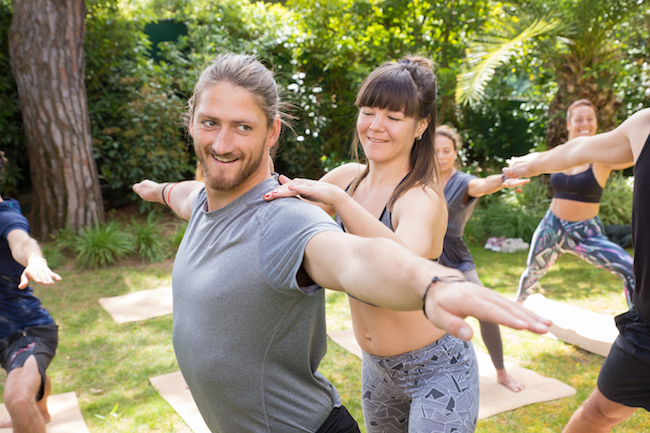Is Ashtanga Yoga Bad for Your Back? (All You Need to Know!)
Ashtanga yoga has earned a bad name for leading to lower back pain and injuries.
But is Ashtanga yoga practice really bad for your back?
As someone who has practiced Ashtanga yoga in the past and from years of studying yoga, it is a very subjective thing to say that Ashtanga yoga is bad for the back…

In reality, Ashtanga yoga is not bad for the back. That said, because the practice is physically demanding, it needs very careful attention, or the chances of creating back pain, aggravating any existing pain, and causing injuries to the back are high.
Since the way we embody our yoga practice is unique, it is difficult to have a single solution to back pain experienced in Ashtanga yoga.
Here we will look at ways in which we can overcome the so called “disadvantages of ashtanga yoga” by honoring and nurturing our practice while making sure that our backs are safe.
What about Ashtanga yoga can be bad for the back?
The practice of Ashtanga yoga is based on a sequence of postures that are repetitive.
The repetitive and set nature of the sequence could mean pushing through the back pain over and over again which can aggravate a pre-existing condition if not done properly.
In other forms of yoga, if there is a certain posture that creates some back pain, it is possible to either avoid it and switch it with another posture, or modify it so it becomes more accessible; not in ashtanga.
Practicing Ashtanga yoga is physically demanding, especially for the back.
On a mental level, the routine of doing the same thing every day without exception is cathartic in its own right.
While this might sound masochistic, Ashtanga yoga is a deeply spiritual practice. It is a mirror that shows us our shortcomings in the clearest possible way.
It makes us flexible and strong in our bodies, but more so in our minds.
But what do you do with your back pain if you want to keep on practicing Ashtanga?
You prevent it from happening or practice some exercises to reduce and remove it.
Let’s start with the former..
Back pain in Ashtanga yoga as a result of lack of awareness
Ashtanga yoga is a continuous flow of postures that are practiced in quick succession.
Most postures are held for not more than 5 breaths, which makes the practice quite agile.
It takes discipline of breath, body, and mind to get this right.
In case there is any mistake in the way the spine is extended, because of the repetitive nature of the practice, the same mistake is also being repeated over and over again.
The other thing about this practice is that to get a posture ‘right’, Ashtangis might find themselves pushing their bodies towards a certain shape.
If a feeling of discomfort arises, it might be perceived as a sign of going ‘deeper’ into the pose.
Pain, especially in the lower back, becomes one of the most common complaints of practitioners for which the most common reason is lack of awareness.
When enough attention is not taken into how the body is held, it can cause the body to slip into and reinforce positions that follow the path of least resistance.
The length and support that is intended to be created in the lower back instead, results in weakening of the muscles and overstretching of the soft tissues and so the spine no longer finds as much support as it needs.
Over time, this creates imbalances in the structure of the lower back leading to pain and even injury.
Back pain in Ashtanga yoga practice as a result of physical change
Iain Grysac, an Ashtanga yoga teacher, has written about how the correct, long-term application of Ashtanga yoga is a structurally transformative process for the body and necessarily involves some experience of discomfort.
He goes on to say that this pain that arises is a sign of correct physical practice and those who do not want significant internal transformation should not practice Ashtanga yoga.
Iain calls this pain as transformational pain – pain arising out of the process of shifting and changing the long-term structural patterns of the body.
This pain has intelligence and functionality, as it is by going through this period of discomfort can a new stability be reached.
Back pain as a result of this transformational restructuring is a common outcome as there is an intense engagement of the back in most postures in Ashtanga yoga.
But, as Iain explains, ashtanga yoga is not bad for the back, even though it can cause temporary pain or discomfort, it’s all part of a greater process of restructuring and shifting the structural patterns of the body.
https://www.youtube.com/watch?v=uREwx6Y9kzYashtanga yoga practice
6 ways to eliminate back pain in Ashtanga yoga practice
The sequences in Ashtanga yoga physical practice involve intense forward and backward bending and deep twists.
There is the dreaded dropping back, putting the legs behind the neck, and the lotus.
If not practiced in complete awareness, small mistakes can cause a lot of pain and sometimes even injuries.
Most Ashtanga teachers, when their students complain of back pain, advise them to continue with their practice, however, with modifications.
This means not pushing oneself in spite of the pain, but working around the pain to create a practice that feels more accessible.
1. Listen to your back
One of the advantages of Ashtanga yoga being a daily practice is that it is difficult to ignore the signals being given by the back.
If there is discomfort or pain and is not being tended to, that voice will only grow louder.
Taking awareness of what hurts and when, is the first step to healing.
Once that is identified, speak to your teacher so they can guide you on how to modify that particular pose or how to work on an aligned area which might help with opening and strengthening that part of the back avoiding injuries.
2. Modify and adapt to what feels best for your back
The sequence of the Full Primary Series of Ashtanga yoga is forward fold heavy.
For those who have past injuries or pre-existing back pain that is triggered by forward bending, Ashtanga yoga might feel out of bounds.
Similarly, the Intermediate series emphasizes backward bending.
If the back is not strong and flexible enough to get into the postures, pushing yourself deeper might only aggravate pain.
While the sequences are clearly defined and well laid out, it is important to be flexible in the mind to not shy away from adapting and modifying the postures to suit what feels best to the back and avoid what brings up pain.
3. Create a careful, conscious, consistent practice
The key to avoiding back pain and injuries while practicing Ashtanga yoga is to create a careful and conscious practice, one that is intelligent and aware.
Another important aspect is consistency – to continue to practice every day, even if it is for a much shorter duration compared to what it used to be.
Many Ashtangis who have complained of back pain and have continued with their practice have found the pain moving to other areas of the body, spreading out, slowly improving, and even completely disappearing.
The sequences in Ashtanga yoga involve intense forward and backward bending and deep twists.
There is the dreaded dropping back, putting the legs behind the neck, and the lotus.
If not practiced in complete awareness, small mistakes can cause a lot of pain and sometimes even injuries.
Most Ashtanga teachers, when their students complain of back pain, advise them to continue with their practice, however, with modifications.
This means not pushing oneself in spite of the pain, but working around the pain to create a practice that feels more accessible.
Would you like to get into the habit of practicing yoga every day? 👉 In this article, we tell you exactly how to start doing yoga every day & stay consistent
4. RETRAIN ON ALIGNMENT AND TECHNIQUE
When it comes to back pain caused by mistakes in alignment, taking a break from the practice might appear to be a good solution but only in the short term.
Unless time is taken to carefully observe the body and re-train when resuming the practice the same pain will arise because those same movements are being repeated.
A good solution is to work closely with the teacher to identify these mistakes and get help with realignment.
5. USE MOVEMENT TO ACCELERATE HEALING OF BACK PAIN
Rest and recuperation allows the spine and soft tissues time to heal.
However, restricting the movements of the back for that purpose slows down that process.
Rather than discontinuing movement in the back altogether, carrying on with gentle movements can help to accelerate and stimulate the healing process and can help overcome back pain sooner.
6. WORK ON ALIGNED BODY PARTS TO HEAL THE BACK
Pain in the back can be caused by factors other than the extension of the back.
Inflexibility of the hips is one such cause.
While performing backbends, if the hips are tight, it can lead to pain or injury. Leg muscles that are tight often contribute to causing weakness and inflexibility in hip muscles.
Working on opening the hip, hamstrings, and calf muscles, and creating strength in the oblique abdominal muscles often helps with finding more flexibility in the back.
What should you expect from an Ashtanga yoga session?
The same set sequence is recommended to be followed at least six days a week (with the exception of full moon and new moon days and the first few days of menstruation for women), and repeated for the rest of a practitioner’s or Ashtangi’s yogic life.
Breath plays a very important role within the practice, and life on the mat always starts with a series of sun salutations.
Ashtangis can practice at their own pace. The role of the teacher is more to guide students than to lead them.
In conclusion, is Ashtanga yoga bad for your back?
The practice of Ashtanga yoga different from hatha yoga; is repetitive, intense, and very demanding.
Because of factors like these, there is a high probability of experiencing pain in the back and other body parts, as well as injuries, especially if there are any mistakes or overlooking.
However, as we have seen in this article, this pain could also be arising from the restructuring and shifting of the structural patterns of the body, which is one of the many benefits of practicing ashtanga yoga.
It may seem counterintuitive to welcome pain, but only by letting it come up when it does and recognizing it for what it is, can it become a force for transformation.
As we have already discussed, it is possible to avoid back pain and injuries when practicing Ashtanga yoga by being fully aware of your body at all times, listening to your back, and being open to modify and adapt whenever necessary to reduce strain on the back.
Ashtanga yoga is a deeply spiritual practice that has immense potential for building self-awareness and moving towards self-transformation but it does come with challenges that can be overcome by being aware of them.
Ashtanga yoga is not only ‘not bad for the back’ but it can actually make the back, the body, and the mind, stronger than they have ever been before.


